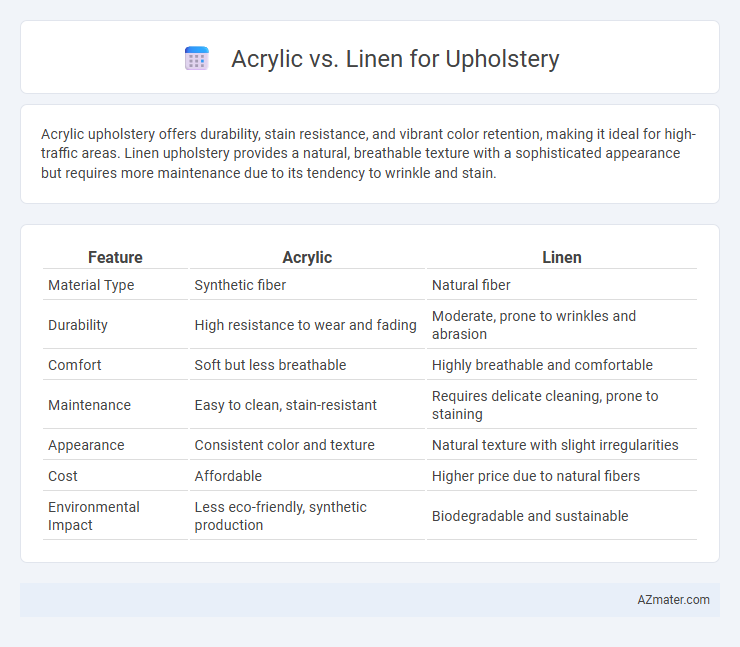Acrylic upholstery offers durability, stain resistance, and vibrant color retention, making it ideal for high-traffic areas. Linen upholstery provides a natural, breathable texture with a sophisticated appearance but requires more maintenance due to its tendency to wrinkle and stain.
Table of Comparison
| Feature | Acrylic | Linen |
|---|---|---|
| Material Type | Synthetic fiber | Natural fiber |
| Durability | High resistance to wear and fading | Moderate, prone to wrinkles and abrasion |
| Comfort | Soft but less breathable | Highly breathable and comfortable |
| Maintenance | Easy to clean, stain-resistant | Requires delicate cleaning, prone to staining |
| Appearance | Consistent color and texture | Natural texture with slight irregularities |
| Cost | Affordable | Higher price due to natural fibers |
| Environmental Impact | Less eco-friendly, synthetic production | Biodegradable and sustainable |
Introduction: Choosing the Right Upholstery Fabric
Acrylic and linen upholstery fabrics offer distinct benefits tailored to different needs, with acrylic known for its durability, stain resistance, and vibrant color retention, making it ideal for high-traffic areas. Linen provides a natural, breathable texture with a classic look, favored for its hypoallergenic properties and eco-friendliness. Selecting between acrylic and linen depends on factors like usage frequency, desired aesthetic, maintenance preferences, and environmental considerations.
Acrylic vs Linen: Material Overview
Acrylic upholstery fabric is a synthetic fiber known for its durability, resistance to fading, and softness similar to wool, making it ideal for high-traffic areas and outdoor use. Linen, a natural fiber derived from the flax plant, offers breathability, a distinct textured appearance, and excellent moisture-wicking properties but tends to wrinkle easily and may lack the stain resistance of synthetic fabrics. Choosing between acrylic and linen depends on balancing durability and ease of maintenance with natural texture and comfort preferences.
Durability and Longevity Comparison
Acrylic upholstery fabrics offer excellent durability with strong resistance to wear, fading, and mildew, making them ideal for high-traffic areas and outdoor use. Linen, while prized for its natural texture and breathability, tends to show signs of wear more quickly, including wrinkling and pilling, thus requiring more maintenance to preserve longevity. For upholstery choices prioritizing long-lasting performance, acrylic fabrics typically outperform linen in durability and sustained appearance over time.
Comfort and Texture Differences
Acrylic upholstery offers a soft, wool-like texture that is resistant to moisture and fading, making it comfortable and durable for everyday use. Linen provides a natural, breathable fabric with a crisp texture that softens over time, delivering a cool and luxurious feel ideal for warmer climates. Comfort-wise, acrylic is plush and cozy, while linen offers a firmer, more textured surface that enhances ventilation.
Stain Resistance and Maintenance
Acrylic upholstery offers superior stain resistance due to its synthetic fibers that repel liquids and resist fading, making it easier to clean and maintain with regular spot cleaning. Linen, a natural fiber, tends to absorb spills quickly and is more prone to staining, requiring professional cleaning and more cautious maintenance to retain its appearance. Choosing acrylic results in more practical, low-maintenance upholstery suitable for high-traffic areas, while linen provides a luxurious look with higher care demands.
Color Retention and Fading Resistance
Acrylic upholstery fabrics excel in color retention and fading resistance due to their synthetic fiber composition, making them ideal for high-traffic and sun-exposed areas. Linen, a natural fiber, offers a luxurious texture but tends to fade more quickly when exposed to direct sunlight, requiring additional care to maintain its vibrant appearance. When long-lasting color vibrancy is a priority, acrylic stands out as the superior choice for upholstery durability.
Cost Analysis: Acrylic vs Linen
Acrylic upholstery fabrics typically cost between $15 and $30 per yard, making them a budget-friendly option compared to linen, which ranges from $30 to $70 per yard due to its natural fibers and premium texture. While acrylic offers durability and stain resistance ideal for high-traffic areas, linen demands higher maintenance but provides breathability and a luxurious aesthetic. When factoring in lifespan and care expenses, acrylic often proves more cost-effective for long-term upholstery projects.
Eco-Friendliness and Sustainability
Acrylic upholstery offers durability and resistance to stains but is derived from synthetic polymers, contributing to environmental pollution and non-biodegradability. Linen, made from flax fibers, is biodegradable, renewable, and requires less water and pesticides during cultivation, making it a more sustainable choice for eco-conscious upholstery. Choosing linen reduces reliance on petrochemicals and promotes a lower carbon footprint throughout the fabric's lifecycle.
Best Applications for Each Fabric
Acrylic fabric excels in upholstery for outdoor furniture and high-traffic areas due to its resistance to fading, moisture, and mildew, making it ideal for patios and sunrooms. Linen, with its natural breathability and luxurious texture, is best suited for indoor upholstery in living rooms and bedrooms where comfort and elegance are prioritized over durability. Choosing between acrylic and linen depends on the balance needed between durability, indoor versus outdoor use, and desired aesthetic appeal.
Final Verdict: Which is Better for Upholstery?
Acrylic upholstery offers excellent durability, stain resistance, and vibrant color retention, making it ideal for high-traffic areas and families with children or pets. Linen upholstery provides a natural, breathable fabric with a luxurious texture but requires more maintenance and is prone to wrinkles and stains, making it better suited for low-traffic or formal settings. The final verdict depends on usage needs: acrylic is better for durability and practicality, while linen excels in aesthetic appeal and comfort.

Infographic: Acrylic vs Linen for Upholstery
 azmater.com
azmater.com